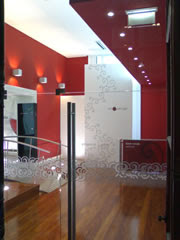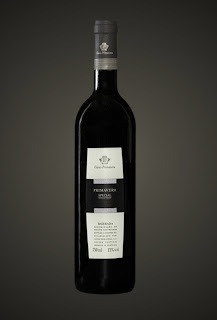.jpg)
As wine tourism goes, this was as good as it gets. Thanks to Andrew Bennett, manager of the Orquestra Nacional do Porto. He cut short his afternoon in the office for the first time in 6 years in order to give us a tour of the city and visit to the Sala Ogival of the estimable institution Vini Portugal in the former Porto Stock Exchange (Palacio da Bolsa). Their tasing rooms are beautifully fitted, clean and modern. Only the piped music was not appropriate to the seriousness and quality of the undertaking but we are realising that is a common lapse in the wine world

Andrew is primarily an administrator and manager of genius; the Orquestra Nacional do Porto is now probably the best in the country and the programme at the iconic Rem Koolhaas Casa da Musica is as imaginative and eclectic as you could find anywhere. This was his first visit to Vini Portugal although he is a veteran of many appearances at the famous Port houses on the opposite side of the Douro where he takes visiting artists.
Vini Portugal runs tastings from different regions every 3 weeks so our wines were Vinhos Verdes, Algarve and Barraida/Beiras. Tânia Branco Oliveira was our exceptionally knowledgeable guide. We learned that Vinho Verde was named after the green region (Minho) where it comes from and not anything to do with the youth or colour of the wine. We had not realised as well as Vinho Verde which is made from Alvarinho, Avesso, Loureiro, Pederna (Arinto) and Trajadura, White wine from the Minho may also be made from 100% Chardonnay, in which case it is named Vinho Regional Minho. Having found in the past Vinho Verde inclining to the sugary and flabby it was a delight to find at least one which could be claimed as a discovery: QM Alvarinho 2008 from Quintas de Melgaco (12.5%), a model of freshness and balance.


There was also a pink Vinho Verde which Andrew had hoped might be the holy grail of roses but which did not make that grade and then on to the Algarve and Barraida and Beiras reds. Here the variety of indiginous Portuguese grapes was in glorious evidence. Tânia told us there are 341 such varieties of which 200 are to be found only in Portugal, meaning that 141 have nonetheless been grown abroad. Some of the wines we sampled consisted of familiar varieties such as Tinta Barroca and Touriga Nacional but we had never got to grips with Baga before this tasting and our second revelation came from Caves Primavera whose Barraida Tinto Special Selection 2003 (Baga with a touch of Touriga Nacional) 13% was definitely outstanding.


In the tiny offshoot of El Corte Ingles thougtfully attached to the Palacio da Bolsa, we were able to buy the Alvarinho QM and a E.24 Dao from Alvaro Castro: "Pape" bought as a present for a certain great Bass singer then present in London whose subsequent report was very encouraging. Pape is an interesting project: a wine made as a joint venture between Alvaro’s Pellada (the ‘pe’) and rented vineyards from Casa de Passarela (the ‘Pa’). There are two wines under this label differing in the amount of Alfrocheiro (a Dao variety) used and the sort of oak. We didn't find the Primavera Baga/Cab Sauv.in any of the wine shops we visited after Vini Portugal.

One of these, "Vinoteca" (Largo S. Domingos 67, just behind the Palacio da Bolsa), was particularly attractive. On Andrew's advice we bought a bottle of 'E.A.', Vasco Maria Eugenio de Almeida, (Conde de Villalva who founded the Adega in 1963).

This and other E.A. wines were also much in evidence at the airport the folowing day. The Colheita Seleccionada Vinho Regional Alentejano 2007 (13.5%, E.7.30) is made from Aragonez (aka Tempranillo), Trincadeira, Alicante Bouschet and Alfrocheiro.


Also the airport were quite good selections at the Duty Free and El Corte Ingles outlets. At the former we bought an entry-level (E.16) Chryseia Douro whose graphics Andrew had quite rightly praised (P+S). This 14% effort is by Bruno Prats and Symington which should be a winning combination. Symington are building a large hotel among the Port warehouses on the front at Vila Nova de Gaia which seems like Porto's left bank but is in fact another town altogether. All the great Port names are there. Rumour has it that some of the English families involved for 300 years in the Port trade still do not speak Portuguese very well and Andrew advises that the cellar tours get better the further from the iron bridge you go.

That evening we had to go to Santa Maria da Feira for a concert at the Europarque. We found an excellent modern restaurant, 'O Conde do Castelo' (Rua Dr. Roberto Alves 15) where we chose a white Douro - CARM (Casa Agricola Roboredo Madeira) branco reserva 2007 which Andrew tells us merits 17 points in the key Portuguese annual wine guide. The grapes for the 2005 vintage were Verdelho, Siria, Rabigato and other Portuguese traditional varieties from vineyards older than 60 years so the 2007 might not be very different. Douro white was previously an unknown quantity. This was a real eye-opener.


At the airport we also bought another Douro Branco, a very pleasurable Follies Loureiro/Trajadura Quinta da Aveleda under 10 Euros.


A welcome feature of most of the wines we tasted and bought was the unassuming alcohol levels. Douro reds and roses may be gravitating towards higher levels but only one of the above wines exceeds 13.5% and of course the Vinho Verdes go as low as 10%.
Douro is the world's oldest DOC but it seems still has many secrets to yield. Wines from the rest of Portugal even more so.
ViniPortugal - Sala Ogival Porto
Palácio da Bolsa, Rua Ferreira Borges 4050-253 Porto Portugal
tel: +351 223 323 072 fax: +351 223 323 074 móvel: +351 916 614 835
e-mail: tania.oliveira@viniportugal.pt site: www.viniportugal.pt
No comments:
Post a Comment